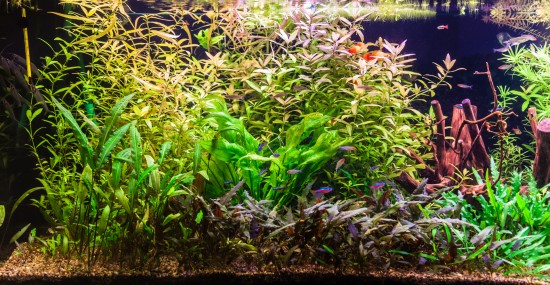

Aquatic plants have adapted to live in a totally different environment to their land based relatives. Running through the plant, from the roots through to the tips of the leaves they have a system of air cavities, allowing them to maintain their buoyancy. Because they spend their lives in the supportive water they have far less supportive tissues when compared to the plants on land.
The one thing that all plants share and need, sunlight for photosynthesis. So this means that they need a green surface to absorb the right wave length of light.
In land plants they have a waxy cuticle to stop them drying out, in aquatic plants this layer is much thinner to help the plants absorb more of the gases.
Okay so sorry here’s the science bit, I’ll keep it simple promise. Plants need a few things to survive
Not all plants that are sold in shops or online as being suitable for in the aquarium are in fact aquatic plants. Many grow along the margins of waterways in marshes and swamps, and may only be submerged for part of the year.
Submersed plants these plants grow completely underwater, and are adapted to live only underwater.
Emergent Plants these plants rise above the surface of the water and might only be submerged only seasonally.
Submersed plants will obviously do better if you plan to keep them under water, that’s not to say you can’t have the Emergent plants in tanks. If you have an open topped tank then they can keep their roots in the water, but let their leaves get out into the air. Just make sure nothing can jump or climb out.
So there are a number of ways of getting CO2 (Carbon Dioxide) to your plants.
Whichever system you use remember that CO2 can rapidly build up to toxic levels and kill the fish, especially if left on overnight or too much is put into the system, so it’s well worth putting your system on a timer to go off before your lights go out. To stay safe most people recommend keeping it under 30 ppm (parts per million).
So substrate, the stuff on the bottom of the tank, serves two main purposes. First to anchor our plants to the bottom of the tank, and secondly and more importantly to provide nutrition. As mentioned you can provide everything they need via liquid fertilizers, but plants have millions of years of evolution saying they get everything through their roots, which need to be in some sort of soil.
Again there are a few options. You can buy complete substrates which are ready to go straight out of the bag, they provide everything your plants need and come in a variety of colours and grain sizes. You can go down the natural route and put in a base layer, often of specific brands of compost designed for land plants, or aquarium compost, then topped with a gravel or sand to stop it turning your water into a shade of mud. However it can be easy for the base substrate to work its way up and make a bit of a mess, and finally you can put in plain sand or gravel and put a capsual of fertilizer by the plants roots, but this can provide a very nutrient rich shot into plants roots. The tabs can be useful to revitalise an old substrate.
Nymphaea lotus; before the floating leaves form on the surface the leaves form underwater in attractive shades of green red and brown, with some purple spots. If you let them grow to the surface they can form beautiful fragrant flower.
Vallisneria Americana var. asiatica is a great plant for the background forming tall twisted green leaves. It is a vigorous plant that is easy to keep and propagates via runners
Hemianthus callitrichorides Cuba is one of the smallest aquarium plants in the world, with tiny millimetre sized leaves. It will spread rapidly and form a carpet across the foreground of your tank. A more challenging plant it can still look stunning.
Copyright © 2005-2016 Pet Information All Rights Reserved
Contact us: www162date@outlook.com